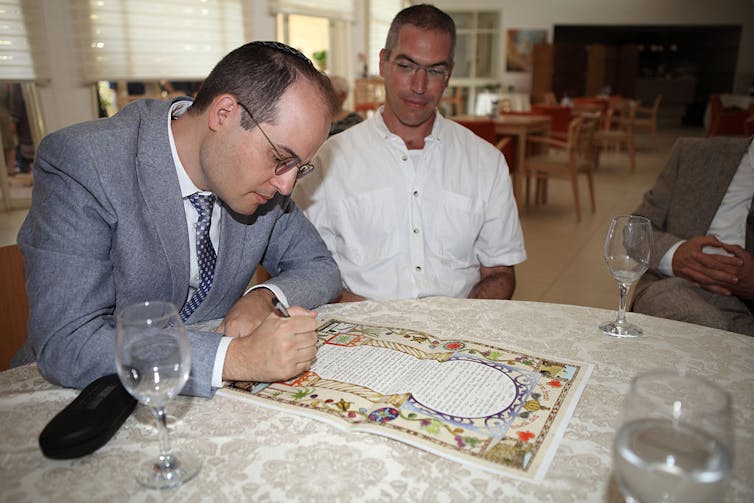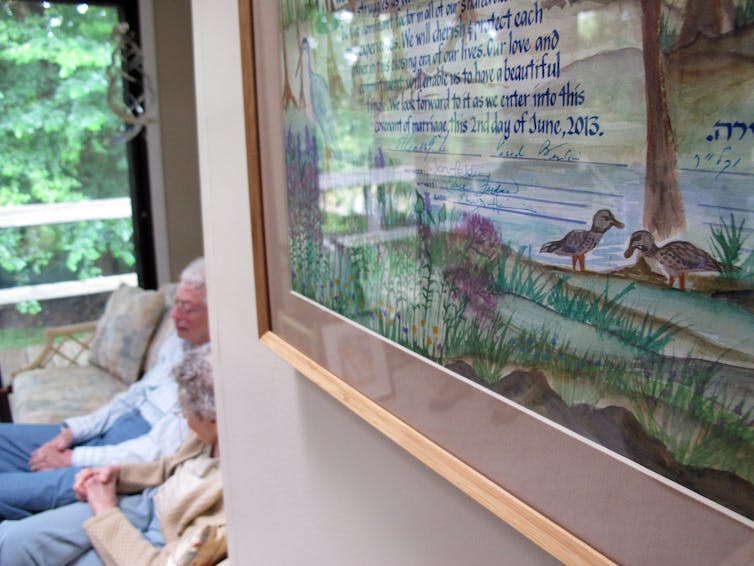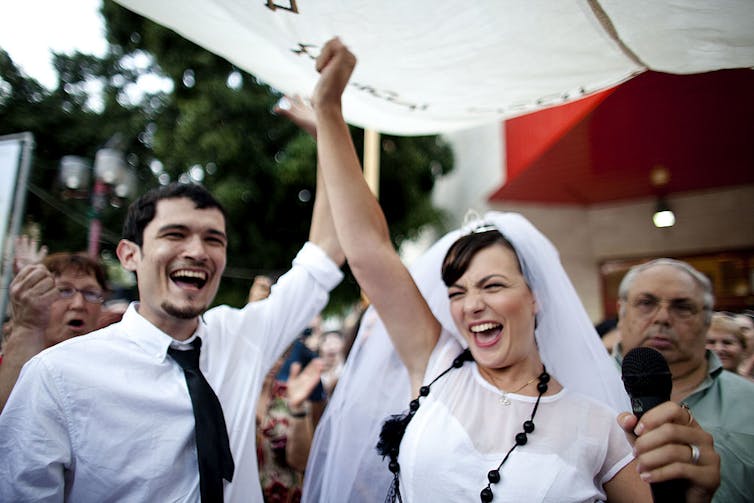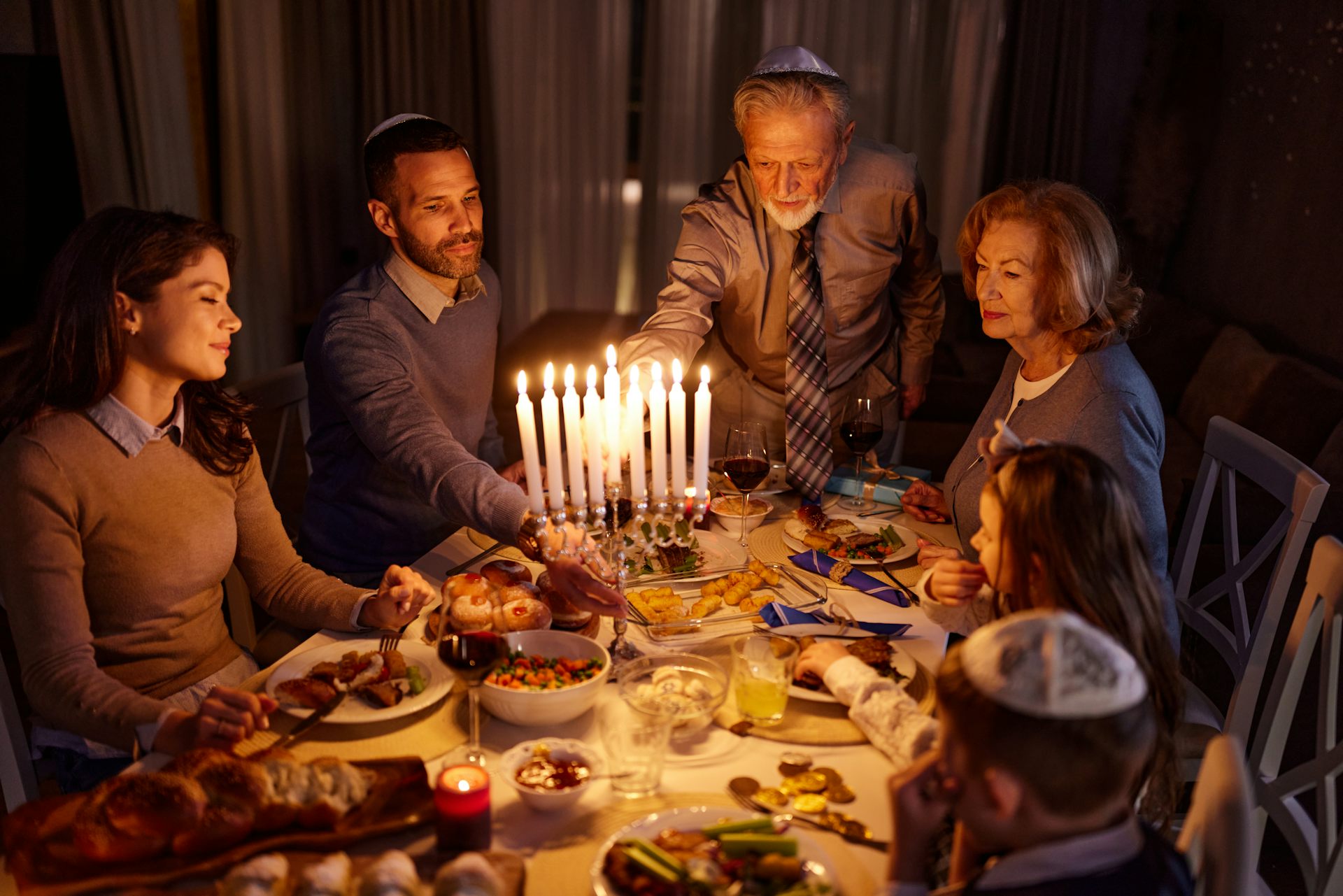From the marriage contract to breaking the glass under the chuppah, many Jewish couples adapt their
Traditional Jewish ceremonies, like Christian ones, marked a woman’s transition from daughter to wife − going from her parents to her husband. But there are creative ways to reflect gender equality while honoring tradition.

Traditional Jewish weddings share one key aspect with traditional Christian weddings. Historically, the ceremony was essentially a transfer of property: A woman went from being the responsibility of her father to being the responsibility of her husband.
That may not be the first thing Americans associate with weddings today, but it lives on in rituals and vows. Think, in a traditional Christian wedding, of a bride promising “to obey” her husband, or being “given away” by her father after he walks her down the aisle.
Feminism has changed some aspects of the Christian wedding. More egalitarian or feminist couples, for example, might have the bride be “given away” by both her parents, or have both the bride and groom escorted in by parents. Others skip the “giving” altogether. Queer couples, too, have reimagined the wedding ceremony.

During research for my book “Beyond Chrismukkah,” about Christian-Jewish interfaith families, many interviewees wound up talking about their weddings and the rituals that they selected or innovated for the day to reflect their cultural background. Some of them had also designed their ceremonies to reflect feminism and marriage equality – something that the interfaith weddings had in common with many weddings where both members of the couple were Jewish.
These values have transformed many Jewish couples’ weddings, just as they have transformed the Christian wedding. Some Jewish couples make many changes, while some make none. And like every faith, Judaism has lots of internal diversity – not all traditional Jewish weddings look the same.
Contracts and covenants
Perhaps one of the most important places where feminism and marriage equality have reshaped traditions is in the “ketubah,” or Jewish marriage contract.
A traditional ketubah is a simple legal document in Hebrew or Aramaic, a related ancient language. Two witnesses sign the agreement, which states that the groom has acquired the bride. However, the ketubah is also sometimes framed as a tool to protect women. The document stipulates the husband’s responsibility to provide for his wife and confirms what he should pay her in case of divorce. Traditional ketubot – the plural of ketubah – did not discuss love, God or intentions for the marriage.

Contemporary ketubot in more liberal branches of Judaism, whether between opposite- or same-sex couples, are usually much more egalitarian documents that reflect the home and the marriage that the couple want to create. Sometimes the couple adapt the Aramaic text; others keep the Aramaic and pair it with a text in the language they speak every day, describing their intentions for their marriage.
Rather than being simple, printed documents, contemporary ketubot are often beautiful pieces of art, made to hang in a place of prominence in the newlyweds’ home. Sometimes the art makes references to traditional Jewish symbols, such as a pomegranate for fertility and love. Other times, the artist works with the couple to personalize their decorations with images and symbols that are meaningful to them.
Contemporary couples will often also use their ketubah to address an inherent tension in Jewish marriage. Jewish law gives men much more freedom to divorce than it gives women. Because women cannot generally initiate divorce, they can end up as “agunot,” which literally means “chained”: women whose husbands have refused to grant them a religious divorce. Even if the couple have been divorced in secular court, an “agunah” cannot, according to Jewish law, remarry in a religious ceremony.
Contemporary ketubot will sometimes make a note that, while the couple hope to remain married until death, if the marriage deteriorates, the husband agrees to grant a divorce if certain conditions are met. This prevents women from being held hostage in unhappy marriages.
Other couples eschew the ketubah altogether in favor of a new type of document called a “brit ahuvim,” or covenant of lovers. These documents are egalitarian agreements between couples. The brit ahuvim was developed by Rachel Adler, a feminist rabbi with a deep knowledge of Jewish law, and is grounded in ancient Jewish laws for business partnerships between equals. That said, many Jews, including some feminists, do not see the brit ahuvim as equal in status to a ketubah.

Building together
Beyond the ketubah, there are any number of other changes that couples make to symbolize their hopes for an egalitarian marriage.
Jewish ceremonies often take place under a canopy called the chuppah, which symbolizes the home that the couple create together. In a traditional Jewish wedding, the bride circles the groom three or seven times before entering the chuppah. This represents both her protection of their home and that the groom is now her priority.
Many couples today omit this custom, because they feel it makes the bride subservient to the groom. Others keep the circling but reinterpret it: In circling the groom, the bride actively creates their home, an act of empowerment. Other egalitarian couples, regardless of their genders, share the act of circling: Each spouse circles three times, and then the pair circle once together.
In traditional Jewish weddings, like in traditional Christian weddings, the groom gives his bride a ring to symbolize his commitment to her – and perhaps to mark her as a married woman. Many contemporary Jewish couples exchange two rings: both partners offering a gift to mark their marriage and presenting a symbol of their union to the world. While some see this shift as an adaptation to American culture, realistically, the dual-ring ceremony is a relatively new development in both American Christian and American Jewish marriage ceremonies.
Finally, Jewish weddings traditionally end when the groom stomps on and breaks a glass, and the entire crowd yells “Mazel tov” to congratulate them. People debate the symbolism of the broken glass. Some say that it reminds us that life contains both joy and sorrow, or that it is a reminder of a foundational crisis in Jewish history: the destruction of the Second Temple in Jerusalem in 70 C.E. Others say that it is a reminder that life is fragile, or that marriage, unlike the glass, is an unbreakable covenant.

Regardless of what it means, some contemporary couples both step on glasses, or have one partner place their foot on top of the other’s so that the newlyweds can break the glass together. The couple symbolize their commitment to equality – and both get to do a fun wedding custom.
There are many other innovations in contemporary Jewish weddings that have much less to do with feminism and egalitarianism, such as personalized wedding canopies or wedding programs. But these key changes represent how the wedding ceremony itself has become more egalitarian in response to both feminism and marriage equality.
Samira Mehta receives funding from the Henry Luce Foundation for work on Jews of Color.
Read These Next
The dystopian Pottersville in ‘It’s a Wonderful Life’ is starting to feel less like fiction
Frank Capra’s dark vision of corruption and greed highlights both the dangers of concentrated power…
Hanukkah celebrates both an ancient military victory and a miracle of light – modern Jews can pick f
Zionists draw on the military imagery of Hanukkah, while others look to the synagogue prayers that focus…
From early cars to generative AI, new technologies create demand for specialized materials
The mass adoption of new technologies drives demand for rare and complex materials used in their manufacture.






